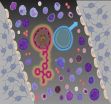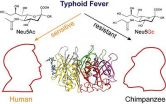INFORMATION:
Female sex hormones can protect against the development of some blood disorders
The study opens the way to a possible use of tamoxifen -- a drug used extensively in the treatment of breast cancer -- for a type of blood disorder for which there is currently no cure
2014-12-04
(Press-News.org) This discovery has a potential application in the treatment of certain blood disorders for which there is currently no cure. The study was led by Dr. Simón Méndez-Ferrer of the CNIC, working in partnership with the laboratories of Doctors Jürg Schwaller and Radek Skoda of the University Hospital in Basel (Switzerland). The study's authors have demonstrated in mice that tamoxifen, a drug already approved and widely used for the treatment of breast cancer, blocks the symptoms and the progression of a specific group of blood disorders known as myeloproliferative neoplasms.
Dr. Méndez-Ferrer explains that scientists have known for some time that men have a higher risk than women of developing leukemia: "We didn't know the causes off this different incidence of leukemia between men and women, but sex hormones like estrogen could at least partly explain these differences." Although estrogens were known to regulate some types of blood cells, very little was known about their influence on blood stem cells, including those that cause myeloproliferative neoplasms.
From this starting point, the researchers discovered an important practical application. "In this study we demonstrate that tamoxifen has specific effects on certain cells in the bone marrow, the hematopoietic stem cells and their immediate descendants, known as multipotent progenitors," explains study author Abel Sánchez-Aguilera.
The researchers found that tamoxifen had very distinct effects depending on whether the mice were healthy or sick. When administered to healthy animals, tamoxifen induced cell death of the multipotent progenitors, whereas the stem cells accelerated their division and partially lost their functionality. But when tamoxifen was administered to sick animals, symptoms disappeared and disease progression was blocked. In short, an effective therapy.
And there's another advantage. Surprisingly, these effects cause hardly any discernable alteration in the rest of the blood cells, which are maintained at normal levels even after prolonged treatment with the drug, showing no appreciable toxicity. Unlike the situation in breast cancer, where tamoxifen blocks the action of estrogens, in blood cells the team found that the drug acts by imitating the function of the hormone.
Myeloproliferative neoplasms, like polycythemia vera, are frequent tumors caused by a mutation in the gene that produces the protein JAK2 in hematopoietic stem cells. These diseases currently have no effective cure apart from bone marrow transplant, which is only possible for a small fraction of patients. The disease causes an accumulation of abnormal blood cells and the degeneration of the bone marrow, and in mice both these processes are blocked by treatment with tamoxifen. The treatment is able to eliminate the abnormal stem cells, the root cause of the disease, something that current therapies, including JAK2 inhibitors, don't manage.
Dr. Simón Méndez-Ferrer points out that "although we don't know yet exactly why, tamoxifen appears to have a stronger effect on leukemic cells than on the healthy ones, which allows the disease to be blocked without producing major secondary effects on normal blood cells."
One of the most remarkable features of this study is its potential for translation to clinical practice in a relatively short time. The study's lead author concludes, "The fact that tamoxifen is already approved for clinical use and has an appropriate safety profile enormously increases the chances of these results leading to a clinical trial to test this potential therapy in patients with myeloproliferative neoplasms."
ELSE PRESS RELEASES FROM THIS DATE:
Wireless brain sensor could unchain neuroscience from cables
2014-12-04
PROVIDENCE, R.I. [Brown University] -- In a study in the journal Neuron, scientists describe a new high data-rate, low-power wireless brain sensor. The technology is designed to enable neuroscience research that cannot be accomplished with current sensors that tether subjects with cabled connections.
Experiments in the paper confirm that new capability. The results show that the technology transmitted rich, neuroscientifically meaningful signals from animal models as they slept and woke or exercised.
"We view this as a platform device for tapping into the richness of ...
Typhoid Mary, not typhoid mouse
2014-12-04
The bacterium Salmonella Typhi causes typhoid fever in humans, but leaves other mammals unaffected. Researchers at University of California, San Diego and Yale University Schools of Medicine now offer one explanation -- CMAH, an enzyme that humans lack. Without this enzyme, a toxin deployed by the bacteria is much better able to bind and enter human cells, making us sick. The study is published in the Dec. 4 issue of Cell.
In most mammals (including our closest evolutionary cousins, the great apes), the CMAH enzyme reconfigures the sugar molecules found on these animals' ...
Obesity and hypertension
2014-12-04
The link between obesity and cardiovascular diseases is well acknowledged. Being obese or overweight is a major risk factor for the development of elevated blood pressure, and cardiovascular diseases. But it has net been known how obesity increases the risk of high blood pressure, making it difficult to develop evidence based therapies for obesity, hypertension and heart disease.
In a ground-breaking study, published today in the prestigious journal, Cell (embargo midday EST), researchers from Monash University in Australia, Warwick, Cambridge in the UK and several American ...
'Satiety hormone' leptin links obesity to high blood pressure
2014-12-04
Leptin, a hormone that regulates the amount of fat stored in the body, also drives the increase in blood pressure that occurs with weight gain, according to researchers from Monash University and the University of Cambridge.
Being obese or overweight is a major risk factor for the development of high blood pressure and cardiovascular disease. Whilst a number of factors may be involved, the precise explanation for the link between these two conditions has been unclear.
In a study published today in the journal Cell, a research team led by Professor Michael Cowley, ...
People with mental illness more likely to be tested for HIV, Penn Medicine study finds
2014-12-04
PHILADELPHIA--People with mental illness are more likely to have been tested for HIV than those without mental illness, according to a new study from a team of researchers at Penn Medicine and the U.S. Centers for Disease Control and Prevention (CDC) published online this week in AIDS Patient Care and STDs. The researchers also found that the most seriously ill - those with schizophrenia and bipolar disease - had the highest rate of HIV testing.
The study assessed nationally representative data from 21,785 adult respondents from the 2007 National Health Interview Survey ...
A poisonous cure
2014-12-04
EAST LANSING, Mich. - Take two poisonous mushrooms, and call me in the morning. While no doctor would ever write this prescription, toxic fungi may hold the secrets to tackling deadly diseases.
A team of Michigan State University scientists has discovered an enzyme that is the key to the lethal potency of poisonous mushrooms. The results, published in the current issue of the journal Chemistry and Biology, reveal the enzyme's ability to create the mushroom's molecules that harbor missile-like proficiency in attacking and annihilating a single vulnerable target in the ...
Research: NFL athletes are seeking unproven stem cell treatments
2014-12-04
Some National Football League (NFL) players have been seeking out unproven stem cell therapies to help accelerate recoveries from injuries, according to a new paper from Rice University's Baker Institute for Public Policy. While most players seem to receive treatment within the United States, several have traveled abroad for therapies unavailable domestically and may be unaware of the risks involved, the paper found.
The paper is published in the 2014 World Stem Cell Report, which is a special supplement to the journal Stem Cells and Development and is the official publication ...
Kent State researchers find more smartphone play equals less fun during leisure
2014-12-04
Today's smartphones are designed to entertain and are increasingly marketed to young adults as leisure devices. Not surprisingly, research suggests that young adults most often use their phones for entertainment purposes rather than for school or work.
With this in mind, three Kent State University researchers, Andrew Lepp, Ph.D., Jacob Barkley, Ph.D. and Jian Li, Ph.D., and a Kent State graduate student, Saba Salehi-Esfahani, surveyed a random sample of 454 college students to examine how different types of cell phone users experience daily leisure.
The trio from ...
Genome sequencing for newborns: What do new parents think?
2014-12-04
Boston, MA - A study published this week in Genetics in Medicine is the first to explore new parents' attitudes toward newborn genomic testing. The findings suggest that if newborn genomic testing becomes available, there would be robust interest among new parents, regardless of their demographic background.
The study, led by researchers at Brigham and Women's Hospital (BWH) and Boston Children's Hospital, found that the majority of parents surveyed were interested in newborn genomic testing.
As next-generation whole-exome and genome sequencing is integrated into clinical ...
Two in 10 adults seriously considered suicide in 2013, CAMH survey shows
2014-12-04
TORONTO, Dec. 4, 2014 - Results from an ongoing survey conducted by the Centre for Addiction and Mental Health (CAMH) show that 2.2 per cent of adults --or over 230,000 people in Ontario, Canada -- seriously contemplated suicide in the last year. The 2013 edition of the CAMH Monitor, released today, included questions about suicidal ideation for the first time in the survey's history.
"Suicide is a major public health issue, and these data confirm that large numbers of Ontario adults report having suicidal thoughts," said Dr. Hayley Hamilton, CAMH scientist and co-principal ...
LAST 30 PRESS RELEASES:
Can community awareness campaigns in low-resource areas improve early diagnosis of colorectal cancer?
Stardust study resets how life’s atoms spread through space
Practical education: Clinical scenario-based program development
The impact of family dynamics on eating behaviour – how going home for Christmas can change how you eat
Tracing the quick synthesis of an industrially important catalyst
New software sheds light on cancer’s hidden genetic networks
UT Health San Antonio awarded $3 million in CPRIT grants to bolster cancer research and prevention efforts in South Texas
Third symposium spotlights global challenge of new contaminants in China’s fight against pollution
From straw to soil harmony: International team reveals how biochar supercharges carbon-smart farming
Myeloma: How AI is redrawing the map of cancer care
Manhattan E. Charurat, Ph.D., MHS invested as the Homer and Martha Gudelsky Distinguished Professor in Medicine at the University of Maryland School of Medicine
Insilico Medicine’s Pharma.AI Q4 Winter Launch Recap: Revolutionizing drug discovery with cutting-edge AI innovations, accelerating the path to pharmaceutical superintelligence
Nanoplastics have diet-dependent impacts on digestive system health
Brain neuron death occurs throughout life and increases with age, a natural human protein drug may halt neuron death in Alzheimer’s disease
SPIE and CLP announce the recipients of the 2025 Advanced Photonics Young Innovator Award
Lessons from the Caldor Fire’s Christmas Valley ‘Miracle’
Ant societies rose by trading individual protection for collective power
Research reveals how ancient viral DNA shapes early embryonic development
A molecular gatekeeper that controls protein synthesis
New ‘cloaking device’ concept to shield sensitive tech from magnetic fields
Researchers show impact of mountain building and climate change on alpine biodiversity
Study models the transition from Neanderthals to modern humans in Europe
University of Phoenix College of Doctoral Studies releases white paper on AI-driven skilling to reduce burnout and restore worker autonomy
AIs fail at the game of visual “telephone”
The levers for a sustainable food system
Potential changes in US homelessness by ending federal support for housing first programs
Vulnerability of large language models to prompt injection when providing medical advice
Researchers develop new system for high-energy-density, long-life, multi-electron transfer bromine-based flow batteries
Ending federal support for housing first programs could increase U.S. homelessness by 5% in one year, new JAMA study finds
New research uncovers molecular ‘safety switch’ shielding cancers from immune attack
[Press-News.org] Female sex hormones can protect against the development of some blood disordersThe study opens the way to a possible use of tamoxifen -- a drug used extensively in the treatment of breast cancer -- for a type of blood disorder for which there is currently no cure







